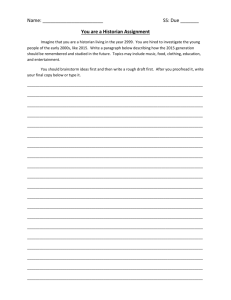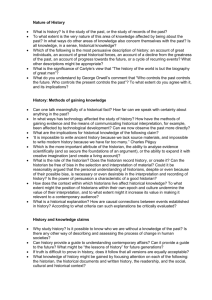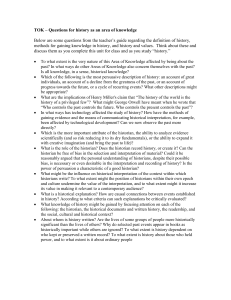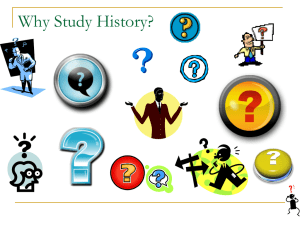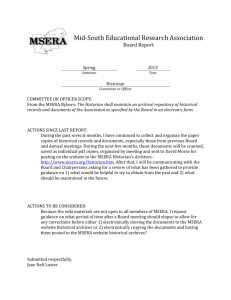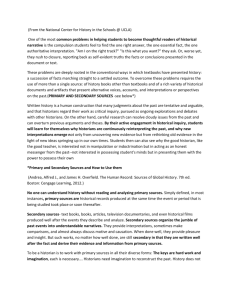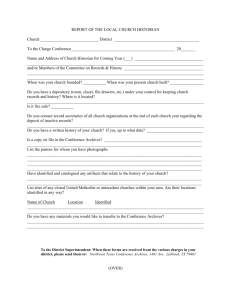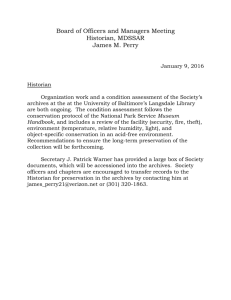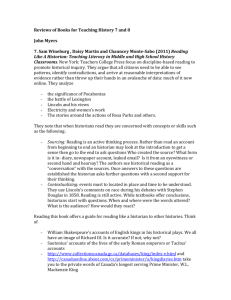Practicum Historiographical Essay Criteria
advertisement
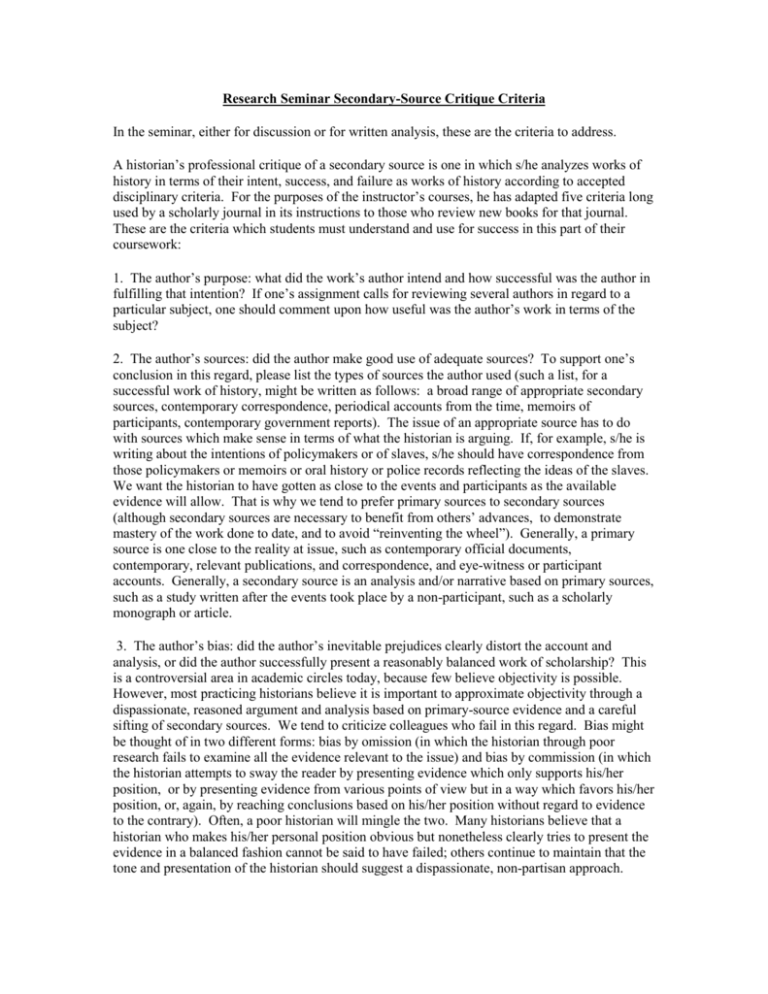
Research Seminar Secondary-Source Critique Criteria In the seminar, either for discussion or for written analysis, these are the criteria to address. A historian’s professional critique of a secondary source is one in which s/he analyzes works of history in terms of their intent, success, and failure as works of history according to accepted disciplinary criteria. For the purposes of the instructor’s courses, he has adapted five criteria long used by a scholarly journal in its instructions to those who review new books for that journal. These are the criteria which students must understand and use for success in this part of their coursework: 1. The author’s purpose: what did the work’s author intend and how successful was the author in fulfilling that intention? If one’s assignment calls for reviewing several authors in regard to a particular subject, one should comment upon how useful was the author’s work in terms of the subject? 2. The author’s sources: did the author make good use of adequate sources? To support one’s conclusion in this regard, please list the types of sources the author used (such a list, for a successful work of history, might be written as follows: a broad range of appropriate secondary sources, contemporary correspondence, periodical accounts from the time, memoirs of participants, contemporary government reports). The issue of an appropriate source has to do with sources which make sense in terms of what the historian is arguing. If, for example, s/he is writing about the intentions of policymakers or of slaves, s/he should have correspondence from those policymakers or memoirs or oral history or police records reflecting the ideas of the slaves. We want the historian to have gotten as close to the events and participants as the available evidence will allow. That is why we tend to prefer primary sources to secondary sources (although secondary sources are necessary to benefit from others’ advances, to demonstrate mastery of the work done to date, and to avoid “reinventing the wheel”). Generally, a primary source is one close to the reality at issue, such as contemporary official documents, contemporary, relevant publications, and correspondence, and eye-witness or participant accounts. Generally, a secondary source is an analysis and/or narrative based on primary sources, such as a study written after the events took place by a non-participant, such as a scholarly monograph or article. 3. The author’s bias: did the author’s inevitable prejudices clearly distort the account and analysis, or did the author successfully present a reasonably balanced work of scholarship? This is a controversial area in academic circles today, because few believe objectivity is possible. However, most practicing historians believe it is important to approximate objectivity through a dispassionate, reasoned argument and analysis based on primary-source evidence and a careful sifting of secondary sources. We tend to criticize colleagues who fail in this regard. Bias might be thought of in two different forms: bias by omission (in which the historian through poor research fails to examine all the evidence relevant to the issue) and bias by commission (in which the historian attempts to sway the reader by presenting evidence which only supports his/her position, or by presenting evidence from various points of view but in a way which favors his/her position, or, again, by reaching conclusions based on his/her position without regard to evidence to the contrary). Often, a poor historian will mingle the two. Many historians believe that a historian who makes his/her personal position obvious but nonetheless clearly tries to present the evidence in a balanced fashion cannot be said to have failed; others continue to maintain that the tone and presentation of the historian should suggest a dispassionate, non-partisan approach. 2 One’s task is to decide if one can detect one or more biases on the part of the historian and if the bias in question has undermined the credibility of the historian’s work. 4. The author’s contribution: Of what use is the work? Does it provide readers with something important and new in either findings or interpretations? If one’s assignment calls for one to read a number of works dealing with the same topic, one may see that over time one author’s work tends to be basic and others merely use it, without adding anything to our understanding. Ideally, each historian is supposed to master what has been done by other historians before him/her and add something new, so that, depending upon when one wrote, one added something that was not there before (although it may then become something well known afterward). Thus, if one is reading a number of works on the same subject, one’s task is to compare the works one has been reading in terms of when they were published to establish who is bringing something new to us and who is simply repeating established material. Note that someone can use previously known material (in terms of research and information) to achieve a new understanding by thinking about the old material in a new way; this, too, is a contribution. If one’s assignment focuses on a subject, one should also address the issue of what the author does for one’s specific research interest (if anything). 5. The author’s failings and the direction for future research: What might be done by the author or another historian to fill the obvious gaps, take the next logical step in the argument, or rectify failings in the work? Here one must not only make an assessment of what is poorly done or incomplete about what the historian set out to do, one must also suggest what the solution to his/her problem might be. For example, if a historian of a war writes his/her account from the point of view of only one of the participants, using archives from only that country, one might note the problem and suggest archival research in the other country. Another historian might write up an analysis of an urban revolt on the part of the poor, using police and newspaper records, but neglect to analyze the policies which provoked the revolt in terms of what the policymakers hoped to accomplish and how they perceived the poor before and after the violence. Such an account fails to address fully the issue of why the revolt took place and what its repercussions might be, because we understand only what the poor did (and, perhaps, something about how they perceived their situation) but we do not understand the larger context in which the revolt took place, without which we cannot ponder its historical meaning and legacy. There may also be cases in which one thinks that the work is without obvious failings. In these cases, it would be best for one to suggest what the next step in research might be to take advantage of such an achievement and move our understanding along further. In this case, try to suggest a research agenda closely tied to the research interests/trajectory obvious in the piece being discussed. It will not do to say that a successful analysis of the movement to abolish slavery in Cuba should be followed up by a study of the Cuban Revolution of 1959 -- the links between the two are too indirect. A more suitable example for the direction of future research would be a study of the political role of Afro-Cubans after abolition.
